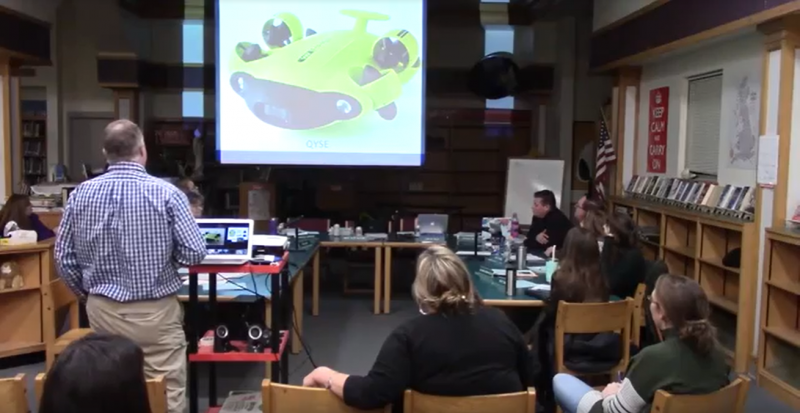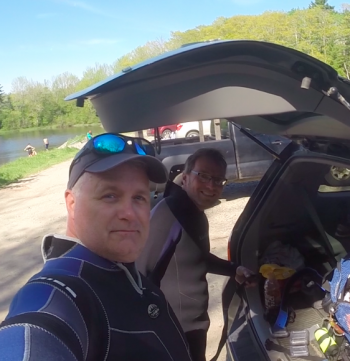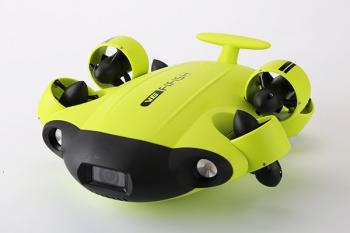BELFAST — Students attending Belfast Area High School will be able to receive a more hands-on marine science education thanks, in part, to a generous grant and the ingenious thinking of two teachers.
Belfast Area High School teachers Chip Lagerbom, who teaches social studies and U.S. history, and David Thomas, who teaches science, received a $1,500 STEM4ME grant from the Perloff Family Foundation to purchase a QYSEA FIFISH V6 underwater robot to study Belfast Harbor, monitor bio-growth and study native and invasive crab species.
The robot first came to attention of Lagerbom when he saw a flyer for a demonstration of the robot at the University of Maine. “It’s going to provide opportunities for kids to engage in cutting edge technology,” said Thomas at a Jan. 13 school board meeting.
Though the event date had passed, Lagerbom was intrigued by the concept and did research to find out more about the robot and its capabilities.
From there, he approached Thomas about building a case for making the purchase from their respective school department budgets.
The duo approached the school’s technology coordinator, Liz Small, in an effort to be able to split the cost three-ways across a trio of departments.
Small encouraged the two men to submit a proposal for a grant to the Perloff Family Foundation.
“We were very excited when the grant was funded and really appreciate the Perloff people helping us in this endeavor,” said Lagerbom.
After receiving the funds to make the purchase, the underwater robot was purchased and the teachers have been learning how to properly operate, manage and maintain the robot since its arrival.
“Using the school pool, we recently did test runs to see how it maneuvered and to practice handling the control console,” said Lagerbom. “Pretty much like a video game controller, this should prove to be little problem for our students.”
The underwater robot, weighing six pounds, will include toggle controls, cameras, temperature and light sensors and virtual reality goggles, and the ability to go under the surface of the water 328 feet. A smart phone operates as the view screen and HDMI capabilities will allow users to the stream the video images onto laptops, ipads and big screens.
The robot carries a battery life of about four-and-a-half hours and can travel at a speed of three knots, with the VR component allowing users to turn their head which results in the robot turning in the identical direction.
With high resolution video and two powerful lights, the robot features an attachable mount Lagerbom believes could be used to connect accessories including a scoop, fork, trowel or small net.
“In fact, using the school's 3-D printers, students involved in the school's engineering projects class might be able to conceptualize, design and fashion our own unique attachments,” said Lagerbom.
With the robot, teachers and students will be able to do surveys of marine life at Belfast Harbor and build a catalog of the flora and fauna of the harbor.
The students could also use the equipment to conduct surveys of the harbor’s moorings every spring, which are moved quite a bit by the ice, and obtain better visuals of shipwrecks lying underneath the harbor’s waters.
“There are a lot of great projects, we’re pretty excited about this opportunity, and really appreciate the Perloff family and the funds that allow us to do something like this,” said Lagerbom during the school board meeting.
The device will primary be used with the marine studies class at Belfast Area High School, with possible use by students at the middle and elementary schools.
Thomas also noted the device could be used by Belfast’s climate crisis committee in conjunction with the Gulf of Maine Research Institute and high school students for sea level monitoring projects at the harbor to monitor bio-growth on water pressure sensors to determine when and how often the sensors needs to be cleaned.
The device could also be used to monitor and study native and invasive crab species in the harbor, including where crabs go in the offseason, and lobster distribution.
The teachers are also excited to see what the students themselves are interested in using the robot for.
Reach George Harvey at: sports@penbaypilot.com.



